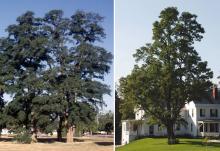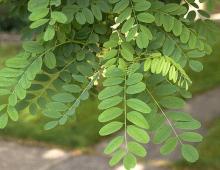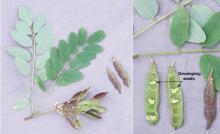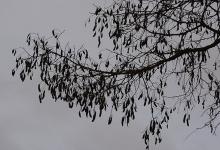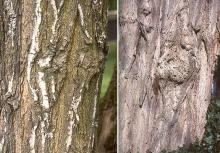- Deciduous tree, 30-50(80) ft [9-15(24) m], upright habit, bark reddish brown to almost black, deeply furrowed. Stems zig-zag, often spiny, with paired stipular prickles at nodes, these are more prominent on vigorous shoots and suckers. Terminal buds absent. Leaves alternate, compound (odd-pinnate), 15-35 cm long, with 7-19 opposite leaflets, each 2.5-5 cm long, elliptic or ovate, bluish green. Flowers white, 2.5 cm pea-type, in 10-20 cm long racemes, fragrant. Fruit pod-like, flat, brown-black 5-10 cm long, mature in Oct.
- Sun, will grow in about any soil except permanently wet. Michael Dirr (p. 1014, 2009) calls it an "alley cat" type tree which can survive under the toughest conditions. Bees produce a delicious honey from the flowers. Twigs and bark are poisonous to domestic livestock.
- Hardy to USDA Zone 3 Native from Pennsylvania to Georgia, west to Iowa, Missouri, and Oklahoma. Extensively planted in the West, where it has escaped from cultivation in many areas. Naturalized in Oregon, mostly in western and northeastern counties.
-
“It was introduced in Europe in the early 1600s and has since become widely naturalized in many countries. A very old tree in a park in central Paris, France, is considered to be the original tree introduced by Jean Robin, planted in 1604, and is still bearing fruit 400 years later (Pasiecznik N, CAB International, personal communication, 2004). Although many forest managers today consider this tree a weed species and a strong competitor against more desirable species, it has been widely planted in some central European countries where it is an important timber species. It is one of the most important stand-forming tree species in Hungary, covering approximately 20% of the forested land and providing 25% of the country's annual timber cut (Redei, 1997). R. pseudoacacia has also been introduced extensively to countries in Africa, Australasia and Asia for control of soil erosion, revegetating denuded hills, land reclamation, rehabilitation of eroded tracts in temperate and subtropical regions, windbreaks, nurse crops, honey production and as an ornamental plant" (from CABI, Invasive Species Compendium).
-
A number of selection in the nursery trade, here are three:
- 'Frisia' - leaves similar to the species type but bright yellow in spring then greenish-yellow in summer
- Twisty Baby™ - multi-stemmed shrub or small tree, zigzag branching, especially on new growth
- ‘Umbraculifera’ - tree/shrub, thornless, mushroom shaped
- Corvallis: Large tree at 10th and Jackson.

